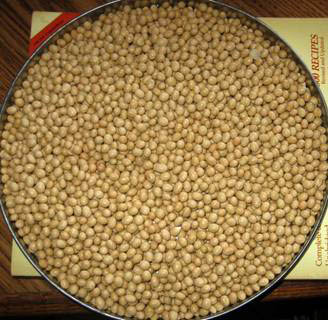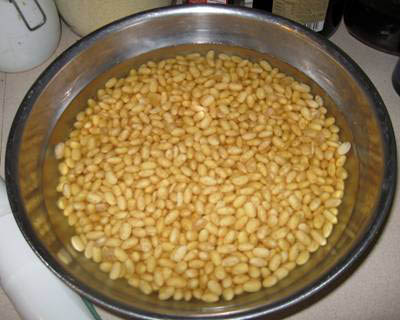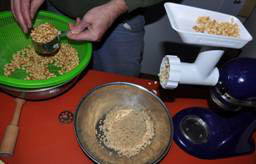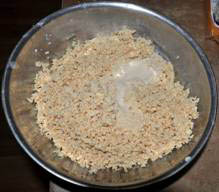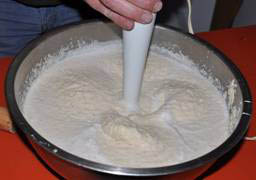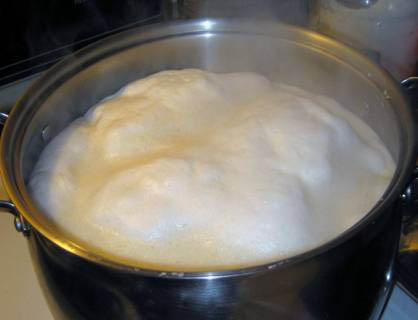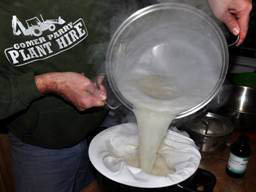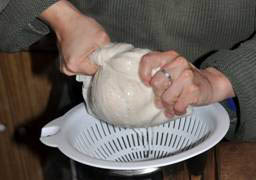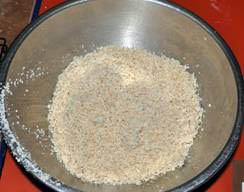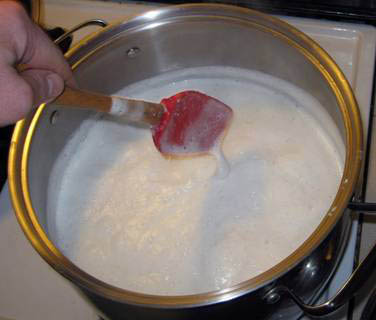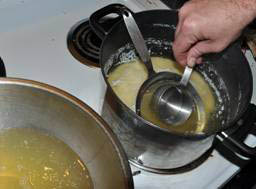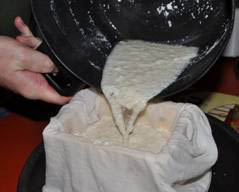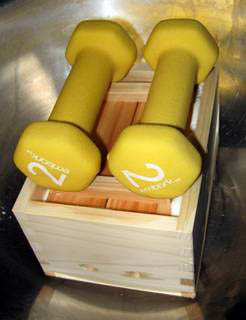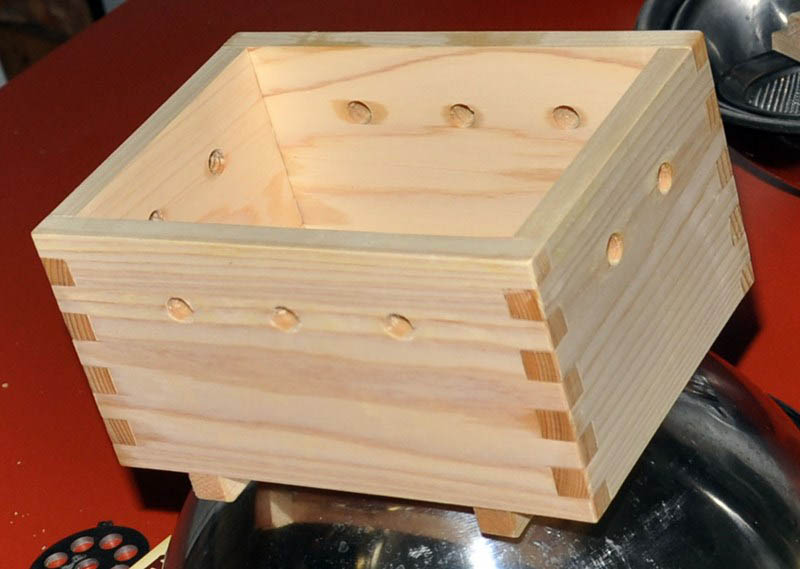
DIY Tofu
The transformation of soybeans into tofu is so complete it is hard to imagine that one comes from the other. It should not thus be surprising that the invention of the process is likely due to the activities of Chinese alchemists. Chinese alchemy arose out of the Taoist tradition, and like alchemy in the west had a principle goal of discovering the secrets to immortality and for transmuting base metals into precious ones. Lord Liu An, the king of Huainan and Taoist philosopher and alchemist, by tradition is said to have invented the process to make both soymilk and tofu around 160 B.C. However, other sources suggest that Lord Liu An simply lived with vegetarian Taoist monks and he learned the method -- based largely on standard alchemical techniques -- from them. In fact, some unattributed sources suggest that the process was actually invented from 400-300 B.C. during the Warring States period. Tofu-making was exported to Japan about 1300 years ago. The soybean to tofu transmutation can be accomplished in your own kitchen in less than two hours with only a few specialized pieces of equipment. The result is tofu that is impeccably fresh and actually has flavor, and at a considerably lower cost than store bought. The principle steps are: (1) soaking dry soybeans until they have fully expanded; (2) grinding these beans to make a soy gruel (called gô in Japanese); (3) cooking the gô to help mobilize soy proteins and deactivate the trypsin inhibitor; (4) straining and pressing the gô to separate the soymilk from the remaining solids, called okara; (5) continue cooking the soymilk to fully deactivate the trypsin inhibitor; (6) curdling the soy milk; and (7) pressing the curds to make a solid block of protein. The following recipe should produce between 1½ - 2 pounds of tofu, and another 4 pounds of okara -- which we’ll use to make tempeh -- depending upon the age of the beans, with fresher soy producing more tofu. Step 1: Soaking the beans4 cups dry soybeans Wash soybeans and soak in water for 10-12 hours. The beans are ready for Step 2 when the two halves are easily split apart, flat, and of the same color throughout. You have over-soaked the beans once small bubbles begin to form on the water surface.
Step 2: Making GôDrain beans, and run through a food grinder using the plate with small (~1/8 inch) holes. When they are all ground, add 4 cups water into the ground beans, and blend using an immersion blender until a smooth gruel is formed. Or, combine whole beans with 4 cups of water and divide into 3-4 batches and process at high speed in a blender.
Step 3: Cooking the GôNow heat 16 cups of water in a heavy-bottomed stock pot. When the water comes to a boil, add in the soybean gruel. Bring to a boil, stirring frequently to make sure that the bottom does not scorch. When the mixture begins to rapidly boil and foam quickly rises in the pot, remove from heat. Be careful to not let it boil over and make a mess of your stove!
Step 4: Straining the SoymilkImmediately strain the hot gô through a cloth bag held in a colander over another large pot. Press out as much of the soymilk as possible using a rubber spatula or glass jar. When you have pressed out most of the liquid, empty the soy grits (okara) into a bowl, and mix in 6 cups of cold water. Stir, and then pour again into the pressing sack. The okara will now be cooler and be able to be squeezed by hand. Keep squeezing and wringing the okara until no more liquid can be squeezed out. Turn the dry okara into a dry bowl and reserve for making tempeh.
Step 5: Cooking the SoymilkCombine the first and second rounds of soymilk into the large kettle (which has been cleaned), and bring to a gentle boil.
Step 6: Curdling the SoymilkRemove boiling soymilk from the heat and let cool to 170° F. This is a vital step, as the coagulation of the soy proteins into curds is temperature dependent, and won’t work well at too high or too low of temperature. If the soymilk is too hot, the curds will be too small and the resultant tofu will crumble easily. If this happens, your best option is to make the tofu into Monk's Loaf. If the soymilk is too cold, your yield of curds will be too low. Mix together 3 tablespoons of your solidifying chemical of choice into 1 cup water. Once the soymilk has reached 170° F (10-15 minutes or so), rapidly stir with a large spoon or spatula to make a vortex. Pour the 1 cup of dissolved solidifying chemical into the vortex, and cover. Let stand for 10 minutes. If at the end of this time the milk has not separated into a clear yellow whey and white curds, stir the liquid gently and add in another 1 tablespoon solidifier mixed into another 1 cup of water and let set another 5 minutes. Nigiri is the Japanese name for bitter magnesium and calcium chloride salts that are removed during the making of table salt (sodium chloride). Seawater has also been historically used to make tofu along the Japanese coast, and will create a nigiri-style tofu. We thus suspect that another potential solidifier would be the ‘instant sea’ salt mixes that can be purchased in an aquarium store for salt-water tanks. But, we’ve never tried this. Step 7: Pressing the curdsOnce the whey is clear and the curds have settled to the bottom, place a large strainer into the pot to hold down the curds, and ladle out the hot whey. Do this until almost all of the whey has been removed, and mostly curds remain in the pot. Remove the tofu block from the press, and carefully unwrap from the pressing sack. Either wrap tofu in cling-film or place in a water bath and refrigerate. Use within 3-4 days.
Specialized ingredients and equipmentYou will need some way to grind the soaked soybeans to make the soy gruel. We use the food grinder attachment to our kitchen mixer, and then follow this up with a secondary grinding with an immersion (or ‘stick’) blender. But, you can do this just as well with a normal kitchen blender. We just don’t own one.
One last thing: you can of course grow your own soybeans for this project. However, the typical soybean grown in the USA has generally been bred for high yields, soy oil, and animal food, not tofu. These varieties have slightly smaller and more yellow beans than typical Japanese varieties. If you can find soy varieties that have been bred for tofu / miso production, you'll likely enjoy your products more. In Japan, the soy varieties considered to have the finest flavors are known by names such as "Child of the White Cranes" and "Waving Sleeves." As far as we are aware, the only source for soybeans especially bred for use in tofu / miso production in the USA is the Kitazawa Seed Company from Oakland, California, who sells a variety called Shinonome (東雲 or Daybreak). |

